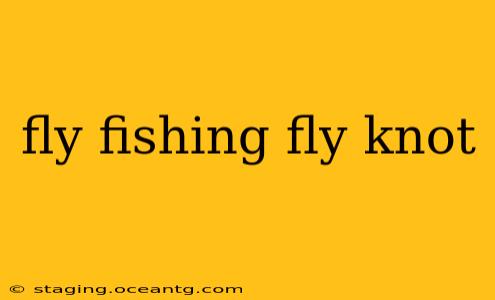Fly fishing, a sport steeped in tradition and precision, demands mastery of various skills, and none is more crucial than tying a reliable fly knot. A poorly tied knot can mean the difference between a successful catch and a lost opportunity. This comprehensive guide will delve into the intricacies of different fly knots, addressing common questions and offering expert tips to enhance your angling prowess.
What are the best fly fishing knots for different situations?
The ideal fly knot depends heavily on the type of fly, the line you're using, and the fishing conditions. There isn't one single "best" knot. However, several stand out as highly effective and versatile.
-
Improved Clinch Knot: This is arguably the most popular and widely used fly knot for its simplicity, strength, and reliability. It's a great all-around choice suitable for most fly lines and flies. It's easy to learn and master, making it perfect for beginners.
-
Blood Knot: Ideal for joining two pieces of fly line of similar diameter, this knot is essential for creating leaders and repairing broken lines on the water. Its strength and reliability make it a must-know for any serious angler.
-
Turle Knot: A more specialized knot primarily used for attaching tippet to the leader or fly line, the Turle knot excels in situations where a smaller, less bulky knot is desirable for delicate presentations.
-
Non-Slip Mono Loop Knot: This knot creates a loop in the end of your tippet that is very secure. This loop can then be attached quickly and easily to a fly. This speeds up fishing and is very useful for quick changes on the river.
What is the easiest fly knot to learn?
For beginners, the Improved Clinch Knot is undoubtedly the easiest to learn. Its straightforward steps and high success rate make it an excellent starting point for anyone new to fly fishing. Numerous online tutorials visually demonstrate the knot's simple process.
How do I tie a fly knot that won't slip?
The key to a secure fly knot lies in proper execution. Regardless of the knot chosen, ensure:
- Sufficient wraps: Follow the instructions carefully, ensuring the specified number of wraps around the hook shank and the fly line.
- Tightening: Pull the knot firmly but gently. Avoid jerking or applying excessive force, which can damage the line or cause the knot to break.
- Wetting the knot: Before tightening, wetting the knot with saliva helps it to settle and improves its strength and security.
- Checking the knot: Before casting, always visually inspect your knot for any loose ends or imperfections. A double-check can prevent a lost fish.
What is the strongest fly knot?
While knot strength depends on factors like line material and execution, the Orvis Knot and the Perfection Loop are often cited for exceptional strength and reliability. However, mastering these more complex knots requires practice.
How do you tie a fly to the leader?
Most anglers use either the Improved Clinch Knot or the Non-Slip Mono Loop Knot to attach a fly to the leader. These knots are efficient, relatively easy to tie, and provide a secure connection.
Conclusion: Practice Makes Perfect
Mastering fly knots is a journey, not a destination. Consistent practice and experimentation with different knots will build your confidence and improve your fishing success. Remember that even experienced anglers occasionally face knotting challenges. The key is to remain patient, persistent, and committed to perfecting your technique. With practice and attention to detail, you'll be confidently tying secure, reliable knots, leading to more successful days on the water.
